the Creative Commons Attribution 4.0 License.
the Creative Commons Attribution 4.0 License.
The millennium-old hydrogeology textbook The Extraction of Hidden Waters by the Persian mathematician and engineer Abubakr Mohammad Karaji (953 CE–1029 CE)
Behzad Ataie-Ashtiani
Craig T. Simmons
We revisit and shed light on the millennium-old hydrogeology textbook The Extraction of Hidden Waters by the Persian mathematician and engineer Karaji. Despite the nature of the understanding and conceptualization of the world by the people of that time, ground-breaking ideas and descriptions of hydrological and hydrogeological perceptions such as components of hydrological cycle, groundwater quality and even driving factors for groundwater flow were presented in the book. Although some of these ideas may have been presented elsewhere, to the best of our knowledge, this is the first time that a whole book was focused on different aspects of hydrology and hydrogeology. More importantly, we are impressed that the book is composed in a way that covered all aspects that are related to an engineering project, including technical and construction issues, guidelines for maintenance, and final delivery of the project when the development and construction were over. We speculate that Karaji's book is the first of its kind to provide a construction and maintenance manual for an engineering project.
- Article
(5251 KB) - Full-text XML
- BibTeX
- EndNote
The 11th-century Arabic book Inbat al-miyah al-khafiya (Arabic:
 ), or The Extraction of Hidden Waters, by Abubakr Mohammad Ebn Al-Hassan Al-Haseb Al-Karaji (Arabic:
), or The Extraction of Hidden Waters, by Abubakr Mohammad Ebn Al-Hassan Al-Haseb Al-Karaji (Arabic:  ) is a pioneering text on hydrogeology (Karaji, 1941). The book is in Arabic, the scholarly language of Persia in the medieval Islamic civilization era. The book was translated from Arabic into Persian by Hoseyn Xadiv Jam in 1966 (Xadiv Jam, 1966). Karaji's book was also translated into French in 1973 (Mazaheri, 1973), into Italian in 2007 (Ferriello, 2007) and into English in 2011 by Abigail Schade in her PhD thesis (Schade, 2011). Schade's English translation was translated from French.
) is a pioneering text on hydrogeology (Karaji, 1941). The book is in Arabic, the scholarly language of Persia in the medieval Islamic civilization era. The book was translated from Arabic into Persian by Hoseyn Xadiv Jam in 1966 (Xadiv Jam, 1966). Karaji's book was also translated into French in 1973 (Mazaheri, 1973), into Italian in 2007 (Ferriello, 2007) and into English in 2011 by Abigail Schade in her PhD thesis (Schade, 2011). Schade's English translation was translated from French.
In an interesting article, Nadji and Voigt (1972) presented a glimpse into the book. They stated that, based on this 11th-century book, the basics of the hydrologic cycle and components of underground water quality were already known by Arab and Persian scientists of that time. They mentioned that the techniques of wells and qanat digging, which were developed for groundwater exploitation in the Middle East, were of such a high standard that they are still in use today. Prompted by Nadji and Voigt (1972), Davis (1973) put Karaji's work into a broader scientific context, explaining the lack of appreciation, value and awareness of Middle Eastern science and scientists in general.
We believe that Karaji's contributions to hydrology and hydrogeology are significant and should be remembered and revisited in this Hydrology and Earth System Sciences special issue on the “History of hydrology”. In this paper, we revisit Karaji's book and provide an English translation of pieces from the book that crucially offer pioneering ideas in hydrogeology and in general for engineering projects. The translations presented here are based on the Persian translation of Karaji's book. We believe it is important to include quotes from Karaji to ensure historical veracity and authenticity and hence a historically faithful paper. It is also fascinating to hear Karaji's thoughts in his own words – bringing his story, his motivations and his scientific contributions to life.
We hope this paper brings about new insights and information that were not provided in the previous written accounts. We hope that it helps to contribute to a growing awareness of Karaji's contributions to hydrology. In the following sections, we provide a short description of Mohammad Karaji's life, explanations of basic components of qanat technology to exploit groundwater resources and finally examine Karaji's book The Extraction of Hidden Waters to shed some light on his knowledge of hydrology and hydrogeology some 1000 years ago.
Abubakr Mohammed Karaji was a late 10th-century–early 11th-century (953 CE–1029 CE) Persian-born Muslim mathematician and engineer. Most of his scientific life was spent in Baghdad. Giorgio Levi Della Vida (1934) mentioned that he was born in Karaj, a city near Tehran, Iran, and was not from the Al-Karkh district of Baghdad, Iraq (Abattouy, 2019). Karaji lived in Baghdad under the Abbasid rulers. We anticipate that he would have been a direct beneficiary of the translation movement. This initiative was begun under the second caliph, Al-Mansur, and continued through to the seventh caliph, Al-Ma'mun, and saw a large amount of significant scientific, religious and other literature translated into Arabic for scholars to use. At this time, Baghdad was one of the world's greatest places of learning and knowledge. It hosted some of the world's best libraries. It was a vibrant place for scholarly activity and scientific discovery. The Middle East became the center of intellectual thought. The modern world owes a great deal to the far-thinking translation initiative of the Abbasid Caliphate and generally to the Islamic (Arabic–Persian) Golden Age civilization.
Most of Karaji's mathematical works were written in Baghdad (O'Connor and Robertson, 2019). His three remaining books on algebra and geometry are Al-Badi' fi'l-hisab (“Exquisiteness of calculation”), Al-Fakhri fi'l-jabr wa'l-muqabala (“Glories of algebra”) and Al-Kafi fi'l-hisab (“Sufficient for calculus”; Abattouy, 2019). The titles of his books on mathematics signal Karaji's perspective on and relationship with mathematics. It portrays his affection for mathematics as spectacular and almighty knowledge. In the introduction of Xadiv Jam's translation, where a historical account of the life and work of Karaji was presented, it was mentioned that Karaji was a contemporary of great Persian scholars such as Avicenna (980 CE–June 1037 CE), Biruni (973 CE–1050 CE) and Razi (854 CE–925 CE).
A short historical perspective of Karaji's importance in the development of mathematics is given at the MacTutor History of Mathematics archive (O'Connor and Robertson, 2019). O'Connor and Robertson (2019) and Woepcke (1853) described the importance of Karaji's work on the first appearance of a “theory of algebraic calculus”. Also, Rashed (1994) wrote the following:
Al-Karaji's work holds an especially important place in the history of mathematics. … the discovery and reading of the arithmetical work of Diophantus, in the light of the algebraic conceptions and methods of Al-Khwarizmi and other Arab algebraists, made possible a new departure in algebra by Al-Karaji.
Karaji described a binomial coefficient theorem similar to the Pascal triangle (O'Connor and Robertson, 2019). Abrarova (1984) described some of Karaji's contributions to geometry. Karaji defined points, lines, surfaces, solids and angles; gave rules for measuring both plane and solid figures; and provided methods of weighing different substances (O'Connor and Robertson, 2019).
In the later years of his life, Karaji returned to the central plateau of his Persian homeland (e.g. Nadji and Voigt, 1972; Lewis, 2001) and wrote the book Inbat al-miyah al-khafiya (The Extraction of Hidden Waters). This book was about practical hydrology in this period. Although it has been mentioned that the book was written by him as a means of earning a living (Nadji and Voigt, 1972), we speculate that the topic was of great practical interest in the arid area of the Persian Plateau. It is also very likely that this topic was of interest to Karaji personally, and he certainly knew it was vitally important. As is mentioned later, in the extracts of Karaji's preface to his book, he notes that to provide people with guidance on how to build a good water supply would be a most beneficial work. The book is considered by some to be “the oldest textbook on hydrology” (Nadji and Voigt, 1972). It is certainly one of the earliest known works focused on both hydrology and hydrogeology. Figure 1 shows a statue of Abubakr Mohammad Karaji at the Water Museum of the Sa'dabad Museum Complex in Tehran, Iran.
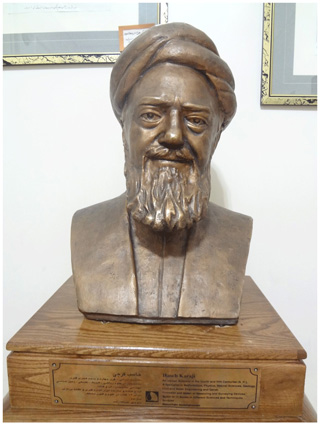
Figure 1Abubakr Mohammad Karaji (953 CE–1029 CE) statue, created by Manouchehr Abollahzadeh, placed at the Water Museum of the Sa'dabad Museum Complex in Tehran, Iran (http://sadmu.ir/post/6, last access: 31 July 2019).
Karaji wrote extensively about qanats in his book. Qanat, or kariz, is an old system of deriving a water supply from an aquifer. Qanat is an Arabic word and kariz is in Persian, although qanat is now also used in Persian. It consists of a gently sloping underground tunnel that brings groundwater to the surface by gravity flow. The main qanat channel is hand-dug and just large enough to fit the person doing the digging, with a series of mother wells and vertical access shafts as it traverses different topographies and geologies along its course (e.g. English, 1968; Semsar Yazdi and Labbaf Khaneiki, 2017). Vertical shafts are used to remove excavated material, to ventilate tunnels and to provide access for maintenance. Qanats are still used in arid and semi-arid climates for the supply of water. Qanat technology was developed for the first time in ancient Persia as far back as the early 1st millennium BCE (e.g. Korka, 2014; Hussain et al., 2008; Wulff, 1968).
Qanat technology spread across the world, first westwards to the Mediterranean and Egypt and then southwards to Oman and the southern Arabian Peninsula. A second major diffusion of qanat technology occurred with the early conquests by Islam into northern Africa, the Iberian Peninsula and the Canary Islands (Lambdon, 1989; Martínez-Santos and Martínez-Alfaro, 2012). Finally, as a consequence of Spanish conquests, the technology also spread to South and Central America, such as Mexico, Peru and Chile (Martínez-Santos and Martínez-Alfaro, 2012).
Karaji's book not only explains his understanding of hydrology at his time but also provides a practical manual on how to construct a qanat.
In the preface to his book, Karaji wrote “I do not know any other profession more beneficial than extraction of hidden water, as it flourishes and cultivates lands, improves people's welfare, and grants ample profits” (translated from Xadiv Jam, 1966). Figure 2 illustrates the first page of Inbāt al-miyāh al-khafiya. This is from a later-century copy of the original book of Karaji that is kept at the University of Pennsylvania, in the Lawrence J. Schoenberg Collection (Karaji, 1675).

Figure 2The first page of Inbāt al-miyāh al-khafiya. Page 1v from Karaji (1675). Permanent link: http://hdl.library.upenn.edu/1017/d/medren/9948256513503681 (last access: 29 July 2019).
Section titles in the book, in Karaji's own words, are as follows: the earth, about hidden waters; the mountains and rocks that indicate water; the lands that indicate water presence; the plants that indicate water presence; about arid mountains and lands; types of water and their tastes, distinguishing water qualities (heavy, light, thick, thin, potable and undrinkable waters); remediation methods for contaminated water; about seasons, about land soils; about the protection zone of wells and qanat based on religious rules; about water flow in a qanat gallery (channel) segment (Tanbooshe); about the slaked lime cement for connecting segments, preparations for water flow without Tanbooshe installation; about application of the invented surveyor's level tool; measurement of mountain heights, the construction of qanats; about reinforcement of underground tunneling excavations; about excavation methods in irregular tunnels; on the maintenance of qanats; dealing with blockages; and about the project delivery from excavators (Xadiv Jam, 1966).
The titles of the book sections provide fascinating insight into the wide range of topics that were covered in the book. It is amazing that the book not only covers the conceptual and technical aspects as well as construction guides but also provides guidelines for maintenance and even advice on how to deliver and consign the project when the development and construction are over. It even touches on important social aspects such as religious regulations. The book is like a construction and maintenance manual for a modern engineering project. Lewis (2001), who explored the history of surveying instruments of the Greeks and Romans, has referred to Karaji's book and his contributions to the procedures and inventive instruments for leveling and sighting in surveying engineering. Karaji's ideas in surveying revealed his sense of engineering, concerning an understanding of accuracies and awareness of essential elements of the construction and exploitation of qanats (Stiros, 2006).
Excerpts from Karaji's book highlight his knowledge of hydrology at the time: “Earth with all its mountains, plains, lowlands and highlands, is of spherical form” (translated from p. 24: Xadiv Jam, 1966). Karaji believed that all components of the universe, such as fire, air, water and soil, have a specific location and intend to get back to their original location when they separate from their source:
… therefore, water flows from distant to closer locations from earth's centre, and by transformation/conversion of air to water in cold days and cold locations and conversion of water to air in hot seasons and warm locations this flow continues and this transformation of water and air to each other is very beneficial for earth affluence (translated from p. 26: Xadiv Jam, 1966).
Obviously, those who lived a millennium ago, had a very different understanding and conceptualization of the world surrounding them. It should be considered that the classical elements of air, earth, fire and water were used by medieval scientists to explain nature:
I have heard that in some islands there are excessive freshwater springs, and there is no doubt that that the source of them is not the surrounding seawater of islands, as the seawater level is lower that the island surface level and seawater is brackish but the springs' water are fresh. However, the sources of these springs are distant locations that have a higher level than the springs' level … (translated from p. 29: Xadiv Jam, 1966).
And a portion of water that infiltrates into ground, when it reaches to hard soil, it avoids infiltration and rests there. And when tunnels are established above these barriers, water enters into these conduits proportional to its force and pressure. (translated from p. 32: Xadiv Jam, 1966).
Karaji referred to the importance of water quality and taste and the possible causes of water quality deterioration:
I saw a river flowing in a valley near a village called Kandeh adjacent to Saveh and its water was fresh. There was rock with three openings inside of the river and drinking the bitter water flushing out of the openings would cause diarrhea. Without any doubt the source of that water was not the rock and the river water, however, this water infiltrated into the ground somewhere far from the rock and flowing into the soils it has passed through in its path caused the change of the water's taste. (translated from p. 32: Xadiv Jam, 1966).
Karaji provided some text on the sources of water and a preliminary indication of the hydrologic cycle:
And God created water in a way that it fills most of earth's cracks and fissures, and its surplus overflows into sea. Thus, the source of most water is snow and rain and transformation of water into air and air into water … (translated from p. 34: Xadiv Jam, 1966).
Based on this quote, and the textbook more generally, we assert that Karaji essentially understood the crux of the hydrologic cycle as we know it today. To appreciate the significance of Mohammad Karaji's 1000-year-old book and his working knowledge of hydrology, it is important to compare it with European knowledge of hydrology in the Middle Ages. The basic principal of hydrology and the correct representation of the hydrologic cycle were represented by Palissy (1509–1590), a French scientist and potter, some 500 or 600 years after Karaji (Duffy, 2017).
Karaji also explains the procedure to extract freshwater from the sea floor:
… seawater is heavy and undrinkable, as sunlight takes its thinness and freshness during a long time. The evidence for this proposition is that sailors exploit and drink freshwater from the sea floor (translated from p. 38: Xadiv Jam, 1966).
The freshwater mentioned at the sea floor is likely due to the discharge of offshore fresh groundwater that is now well known and is referred to today as submarine groundwater discharge (Post et al., 2013).
Karaji provided observations and evidence which can be considered to describe groundwater–surface water interactions in today's nomenclature:
… that water in the wells rises when water in rivers increases and falls when that decreases, to the extent that the water level in a well would be the same as the water level in a river (translated from p. 40: Xadiv Jam, 1966).
… and the rainwater infiltrates into earth openings and gaps till water encounters a horizontal barrier and stops there (p. 41: Xadiv Jam, 1966).
It appears that this shows an understanding of recharge processes and the way in which water interacts with rocks – earliest conceptions of “hydrogeology” – the study of water and rock.
Karaji provided explanations about soil and rock classifications based on their colors and characteristics and described the indicators that could be used to find out where water might be available underground and in springs. One of the indicators that Karaji stated could be usefully employed is lush land and the ampleness of vegetation and trees – indicators of the potential dependence of vegetation and ecosystem health on groundwater – what we call groundwater-dependent ecosystems today. He even specified the type of plants in this regard based on observations and reliable narratives. Simmons (2008) wrote about Father Paramelle as a naturalist who published The Art of Discovering Springs the same year as Darcy (1856) and the publication of Darcy's law. Paramelle's work was the bestseller not Darcy's. Darcy disliked Paramelle's works to begin with but eventually came around to see the usefulness in Paramelle's observations and recognized him as a good geologist concerned with underground hydrography (Simmons, 2008). Fascinatingly, Paramelle provided similar observations to Karaji, about 800 years later.
Karaji described the influence and interaction of soil and vegetation on the water passing through them:
And snow water and rainwater are the most delectable water, and afterwards the water that flows over impeccable soils or over sand and fine stone pieces, and in channels without any vegetation. The taste of other water, that does not have these features, would change by the soil and vegetation in their path (translated from p. 50: Xadiv Jam, 1966).
Karaji described important water quality and sanitary matters and the possible illnesses caused by unhealthy water based on water taste, odor, weight and temperature. He also proposed some methods to treat brackish and unhealthy water:
… whenever in a container of brackish or heavy water clean and neat ground soil would be added and then put the container aside till water is still and clear, some part of salinity and heaviness would be removed. If this procedure is repeated water gets improved; and if this water is poured into a new pot till water leaks and drops from its bottom, a portion of salinity and heaviness is removed (translated from p. 53: Xadiv Jam, 1966).
The treatment Karaji outlined is essentially a water filtration process based on the knowledge and apparatus of the time.
Karaji went on to provide explanations about different seasons and their influence on water quantity. He provided a brief outline of climatology knowledge of the time. He wrote about different types of soils and their influence on the stability of the excavated qanat. Karaji described methods and measures to find the location of water underground. For example,
If there are dry pits or wells and we want to know if there is any water there or not, a piece of dry or oiled wool which in connected to a string is dangled into the well, if the wool does not reach to the bottom of the well and does not touch the well's wall, and it is suspended for three hours in this situation and it is taken out after that, if there is moisture in the wool then there is water in that place (translated from p. 61: Xadiv Jam, 1966).
He explained the effect of earthquakes on groundwater flow:
once an earthquake occurs springs gush and sometimes new springs appear, or the location of springs are displaced (translated from p. 61: Xadiv Jam, 1966).
Karaji described underground water flow:
Of course, it is not possible that water of a spring or well or lagoon gushes or rises up, unless its source is in a location that is higher than the location of gushing (translated from p. 63: Xadiv Jam, 1966).
Concepts such as mass, force, energy, gravity field, and many other physical properties and processes, which are easily comprehensible now, did not exist in 11th-century conceptualizations of the universe. However, we may speculate that there are some very early insights into the modern-day concept of hydraulic head – namely that groundwater flows from points of high hydraulic head to points of low hydraulic head – in Karaji's descriptions of water flow. We are unaware of any other documented cases where ideas of groundwater flow, from higher grounds to lower grounds, had been published any earlier than Karaji's treatment.

Figure 3Illustrations of surveyor's leveling apparatus. Diagrams f23v and f24r from Karaji (1675). Permanent link: http://hdl.library.upenn.edu/1017/d/medren/9948256513503681 (last access: 29 July 2019).
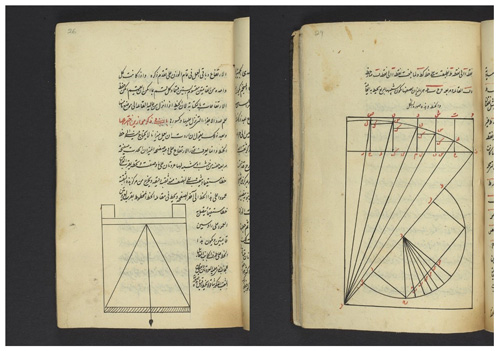
Figure 4Illustrations of surveyor's level apparatus invented by Karaji and the proof and description on its application. Diagrams f26r and f29r from Karaji (1675). Permanent link: http://hdl.library.upenn.edu/1017/d/medren/9948256513503681 (last access: 29 July 2019).
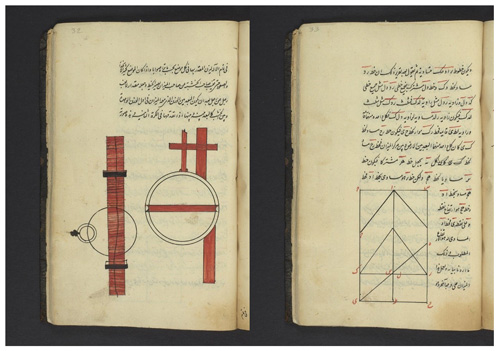
Figure 5Illustrations of surveying apparatuses to measure distance and level and the proof and description on its application. Diagrams f32r and f33r from Karaji (1675). Permanent link: http://hdl.library.upenn.edu/1017/d/medren/9948256513503681 (last access: 29 July 2019).
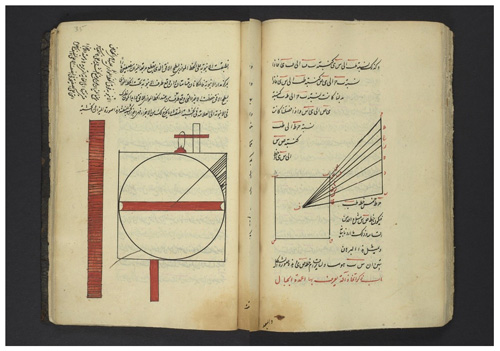
Figure 6Illustration for the proof on how to vertically describe how to measure and determine the height of a mountain. Diagrams f35r and f36v from Karaji (1675). Permanent link: http://hdl.library.upenn.edu/1017/d/medren/9948256513503681 (last access: 29 July 2019).
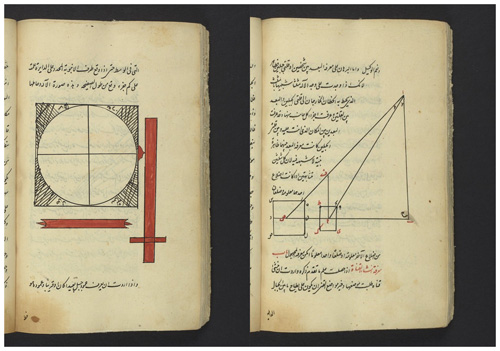
Figure 7Illustrations for the apparatus and to describe how to measure and determine the height of a mountain. Diagrams f37v and f40v from Karaji (1675). Permanent link: http://hdl.library.upenn.edu/1017/d/medren/9948256513503681 (last access: 29 July 2019).
To understand how different the conceptualization of the world was in pre-Renaissance times, the following is a quote from da Vinci (1452–1519) to explain water flow, in which he creates an analogy between water flow and blood circulation in the human body:
Natural heat keeps blood in the veins at the top of the man, and when the man has died this blood becomes cold and is brought back into the low parts, and as the sun warms the man's head the amount of blood there increases, and it grows to such an excess there with the humors as to overload the veins and frequently to cause pains in the head.
It is the same with the springs that ramify through the body of the earth and, by the natural heat which is spread through all the body that contains them, the water stays in the springs and is raised to the high summits of the mountains. And the water that passes through a pent-up channel within the body of the mountain like a dead thing will not emerge from its first low state, because it is not warmed by the vital heat of the first spring. Moreover the warmth of the element of fire, and by day the heat of the sun, have power to stir up the dampness of the low places and draw this to a height in the same way as it draws the clouds and calls up their moisture from the expanses of the sea. (p. 199, Suh, 2013).
Humor is Latin for moisture. Da Vinci, who is recognized as one of history's most brilliant minds, lived 500 years after Karaji's time. We may appreciate Karaji's profound knowledge of hydrology and hydrogeology, especially when considered in the context of his time. Da Vinci was clearly on the incorrect path with water flowing uphill. However, Karaji seems to be very close to understanding the core of the hydrologic cycle and the mechanisms of water flow from higher ground levels to lower ground levels. We note that it was only in the 17th century that a clear understanding of the hydrologic cycle was finally realized (Todd and Mays, 2004).
Fascinatingly, the protection boundary of wells and qanats based on religious laws are described by Karaji. For example, Karaji explained that whoever dug a well, with the permission of the ruler, the digger would be the owner of the well. There would also be a protection zone of 40 cubits (about 20 m) for this well. However, if the well was established illegally, the digger would not be the owner and there would be no protection zone for that well. The protection zone for qanat is 500 cubits (about 250 m; p. 67: Xadiv Jam, 1966). The issue of the protection boundary of wells and qanats based on religious laws was explained by Karaji in his book from p. 67 to 71 (Xadiv Jam, 1966). In his explanations he referred to the opinion of Islamic law scholars (e.g. Hassan Basri, Abu Yousef, Abu Hanifeh) who had referred to the prophet Mohammad's practices and sayings. It is intriguing to note that the only available and ruling law at the time in the Islamic world was strictly based on religious ideas and texts. Thus, all matters relating to ownership, property and rights were based entirely on religious ideas and works. These were developed, promoted, espoused and written entirely by religious scholars. They were linked to the practice of the prophet Mohammad and his companions' practices. Karaji's work began to bring science, engineering, maths and technology to this important – and at that time entirely religious – legal discussion, principles and practice.
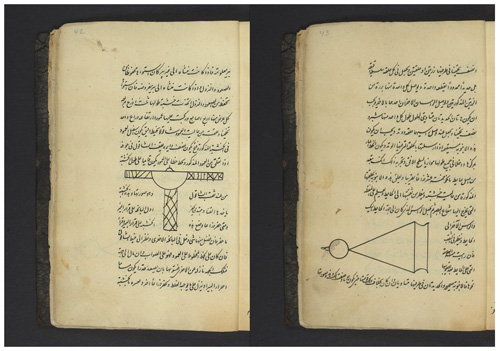
Figure 8Illustration of the apparatuses for checking the straightness of the qanat's tunnel and sighting tube for qanats. Diagram f42r and f43r from Karaji (1675). Permanent link: http://hdl.library.upenn.edu/1017/d/medren/9948256513503681 (last access: 29 July 2019).
Next, Karaji defined protection limits based on his knowledge and consideration of differing soil types: “The protection areas of qanat in hard soils is less than that for loose soils.” (translated from p. 74: Xadiv Jam, 1966). Karaji understands that wells placed in the more permeable material (the loose soils) require a greater area or size for the groundwater protection zone around it compared to that in the less permeable material (the hard soils). Groundwater protection or buffer zones are based on the very same principle today – a principle that Karaji conceived a thousand years ago. We speculate that what Karaji mentioned here is related to his intuitive understanding of the ease of water flow in loose soils compared to that in hard soils. It is possible that Karaji understood that water flowed more easily through loose soils than it did through hard soils – leading to a concomitant increase in the size of the protection zone for a well in the more permeable material (the loose materials). This may be some of the earliest documented insights into the rates and ease of groundwater flow through different geologic materials – the earliest conceptions of what we would call hydraulic conductivity today. They are also earliest known documented conceptions of modern-day hydrogeology.
Karaji reported possible complications during qanat excavation and described the technical solutions to overcome them. Moreover, he reported how to prepare the construction works and prepare qanat tunnels. He provided detailed methods to level the construction sites and illustrated the apparatus that can be used for leveling in both horizontal and vertical directions and the methods for surveying and planning qanat construction (93–141: Xadiv Jam, 1966). Figures 3–8 illustrate diagrams and schematics from a later-century copy of the original manuscript of Karaji's book showing surveying and leveling apparatuses as well as the proofs and descriptions of their applications (Karaji, 1675). Karaji provided elaborate explanations on stabilizing techniques for tunnel excavation procedures (142–150: Xadiv Jam, 1966). He explained how to plan and dig in a tortuous conduit and how to open, maintain and dredge qanats (151–162: Xadiv Jam, 1966). Figure 9 illustrates a caliper, a ruler and the schematic for planning how to dig in a tortuous qanat (Karaji, 1675).
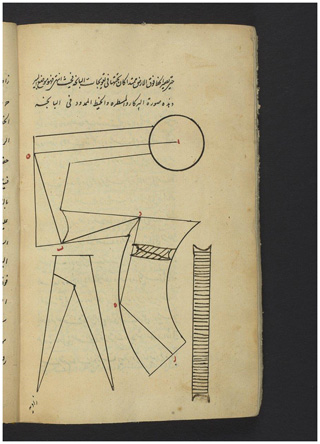
Figure 9Illustrations of calliper, ruler, and planning and procedure to dig in a tortuous qanat and record deviations. Diagram f45v from Karaji (1675). Permanent link: http://hdl.library.upenn.edu/1017/d/medren/9948256513503681 (last access: 29 July 2019).
Karaji's pioneering scientific and engineering contributions to hydrology and hydrogeology through his book The Extraction of Hidden Waters are seminal and significant. Despite this, we and other authors have noted that his contributions to hydrologic and groundwater science have been largely unknown and hence greatly undervalued and underappreciated. The fact that full translations of his work into other languages did not exist until modern times (e.g. French translation in 1973, Italian in 2007 and English in 2011) is probably a key reason for this. The situation may have been different if translations had occurred much earlier, but this was not common at the time. Thus, his contributions, we surmise, were simply not known.
It is abundantly clear from our article, and a small number of previous papers on this matter, that Karaji both thought about and proposed interesting, important and prescient ideas about hydrology and hydrogeology in the Middle Ages hundreds of years before European thinkers. Many of Karaji's ideas have stood the test of time and are as true today as they were a thousand years ago. Karaji was a prognostic hydrologist and hydrogeologist hundreds of years ahead of his time. Beyond the specific topic of Karaji's book on the extraction of hidden waters, the comprehensive content, details and topics that he has covered in the book are very impressive for engineering construction project management. This important point has not been noted before, to the best of our knowledge. Therefore, Karaji's book is not only, according to some, “the oldest textbook on hydrology” but also among the earliest known texts on engineering construction management. It is certainly one of the earliest known works focused on both hydrology and hydrogeology.
Like previous authors, we too assert that Karaji deserves more credit in hydrologic and groundwater science and engineering than has been the case to date. We hope our paper plays a part in rectifying this. We hope that it helps to bring Karaji – the scientist and his science – to the attention of current and future generations of hydrologists, hydrogeologists, scientists and engineers around the world.
No data sets were used in this article.
BAA and CTS both contributed to the research, writing and reviewing of the paper.
The authors declare that they have no conflict of interest.
This article is part of the special issue “History of hydrology” (HESS/HGSS inter-journal SI). It is not associated with a conference.
We acknowledge the editor, Keith Beven, and the helpful reviews provided by S. Majid Hassanizadeh, Stathis C. Stiros, and one anonymous referee, as well as the short comment by Joeri van Engelen. Behzad Ataie-Ashtiani acknowledges support from the Research Office of the Sharif University of Technology, Iran, and the National Centre for Groundwater Research and Training, Australia.
This paper was edited by Keith Beven and reviewed by S. Majid Hassanizadeh, Stathis C. Stiros, and one anonymous referee.
Abattouy, M. and Muhammad Al-Karaji, A.: A Mathematician Engineer from the Early 11th Century, Muslim Heritage, available at: http://www.3mpati.com/muslimheritage/muhammad-al-karaji/, last access: 10 June 2019.
Abrarova, M. A.: The geometrical section of al-Karaji's treatise `Comprehensive book of arithmetic' (Russian), in: Mathematics and astronomy in the works of Ibn Sina, his contemporaries and successors (Tashkent, 1981), Tashkent, 118–125, 1981.
Darcy, H.: Les Fontaines Publiques de la Ville de Dijon [The Public Fountains of the City of Dijon], Dalmont, Paris, 1856.
Davis, S. N.: Discussion of “Exploring for hidden water” by Mohammad Karaji – The oldest textbook on hydrology?”, Groundwater, 11, 45, 1973.
Duffy, C. J.: The terrestrial hydrologic cycle: an historical sense of balance, WIREs Water, 4, e1216, https://doi.org/10.1002/wat2.1216, 2017.
English, P. W.: The origin and spread of qanats in the old world, Proc. Am. Philos. Soc., 112, 170–181, 1968.
Ferriello, G.: L'estrazione delle acque nascoste: trattato tecnico-scientifico di Karaji: matematico-ingegnere persiano vissuto nel Mille, KWB, Turin, 2007.
Hussain, I., Abu Rizaiza, O. S., Habib, M. A., and Ashfq, M.: Revitalizing a Traditional Dryland Water Supply System: The Karzes in Afghanistan, Iran, Pakistan, and the Kingdom of Saudi Arabia, Water Int., 33, 333–349, 2008.
Karaji, M.: Inbāt al-miyāh al-khafiya, Written in Iraq or Persia, Printed 20 February 1674, University of Pennsylvania, Lawrence J. Schoenberg Collection: LJS 399 – Karaji?, Muhòammad ibn al-Hòusayn, d. ca. 1016, available at: http://hdl.library.upenn.edu/1017/d/medren/9948256513503681? (last access: 29 July 2019), 1675.
Karaji, M.: Kitab Inbat Al-Miyah Al-Khafiyah [“Extraction of HiddenWaters”], al-Tabah, 1st Edn., Hyderabad al-Dakkan, Matbaat Dairat al-Maarif al-Uthmaniyah, Arabic edition, Hyderabad, 1941.
Korka, E.: The Protection of Archaeological Heritage in Times of Economic Crisis, Cambridge Scholars Publishing, Cambridge, 400 pp., ISBN-10 1443866229, 2014.
Lambdon, A. K.S .: The origin, diffusion and functioning of the qanat, in: Qanat, kariz & khattara: Traditional water systems in the Middle East and North Africa, edited by: Beaumont, P., Bonine, M., and McLachlan, K., Middle East and North African Studies Press Ltd., London, 1989.
Levi della Vida, G.: Appunti e quesiti di storia letteraria araba. 4. Due nuove opere del matematico al-Karagi (al-Karkhi), Rivista degli Studi Orientali (Roma), 14, 249–264, 1934.
Lewis, M., Surveying Instruments of Greece and Rome, Cambridge University Press, Cambridge, 389 pp., 2001.
Martínez-Santos, P. and Martínez-Alfaro, P. E.: A Brief Historical Account of Madrid's Qanats, Groundwater, 50, 645–653, 2012.
Mazaheri, A.: La Civilisation Des Eaux Cachées; Traité De l'Exploitatiôn Des Eaux Souterraines, French translation od Arabic text, Études Préliminaires, 6, Université de Nice, Institut d'études et de recherches interethniques et interculturelles (I.D.E.R.I.C), Nice, 1973.
Nadji, M. and Voigt, R.: “Exploring for hidden water” by Mohammad Karaji – The oldest textbook on hydrology?, Ground Water, 10, 43–46, 1972.
O'Connor, J. J., Robertson, E. F., and Abu Bekr ibn Muhammad ibn al-Husayn Al-Karaji: MacTutor History of Mathematics archive, available at: http://www-history.mcs.st-andrews.ac.uk/Biographies/Al-Karaji.html, last access: 19 July 2019.
Post, V. E. A., Groen, J., Kooi, H., Person, M., Ge, S., and Edmunds, W. M.: Offshore fresh groundwater reserves as a global phenomenon, Nature, 504, 71–78, https://doi.org/10.1038/nature12858, 2013.
Rashed, R.: The development of Arabic mathematics: between arithmetic and algebra, Springer Nature, London, 1994.
Schade, A.: Hidden waters: groundwater histories of Iran and the Mediterranean, PhD Dissertation, Graduate School of Arts and Sciences, Columbia University, USA, p. 282, 2011.
Semsar Yazdi, A. A. abd Labbaf Khaneiki, M.: Qanat Knowledge: Construction and Maintenance, Springer Netherlands, 188 pp., ISBN 13 978-94-024-0957-4, 2017.
Simmons, C. T.: Henry Darcy (1803–1858): Immortalised by his scientific legacy, Hydrogeol. J., 16, 1023–1038, 2008.
Stiros, S.: Accurate measurements with primitive instruments: The “paradox” in the qanat design, J. Archaeolog. Sci., 33, 1058–1064, 2006.
Suh, H. A.: Leonardo's Notebooks: Writing and Art of the Great Master, Da Vinci, Leonardo (Author), H. Anna Suh (Editor), Black Dog & Leventhal Publishers, New York, 448 pp., ISBN-13 978-1579129460, 2013.
Todd, D. K. and Mays, L. W.: Groundwater Hydrology, 3rd Edn., John Wiley & Sons Inc., USA, 656 pp., ISBN 978-0-471-05937-0, 2004.
Woepcke, F.: Extrait du Fakhri, traité d'Algèbre par Abou Bekr Mohammed Ben Alhacan Alkarkhi, Imprimerie impériale, Paris, 1853.
Wulff, H. E.: The Qanats of Iran, Scient. Am., 218, 94–105, 1968.
Xadiv Jam, H.: Extraction of underground waters, Institute for Humanities and Cultural Studies, Iranian, Persian translation of Arabic text, Intisharat Bunyad-i Farhang-i National Commission for UNESCO, Tehran, Iran, 164 pp., 1966.





